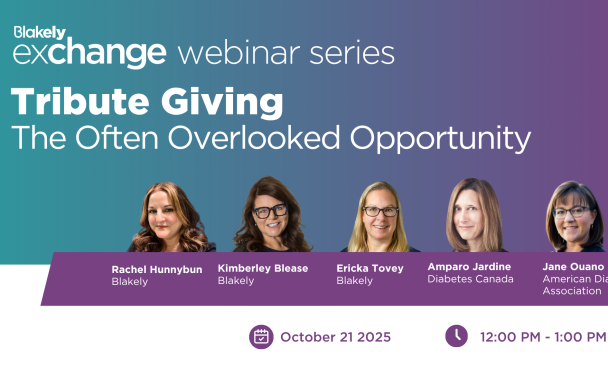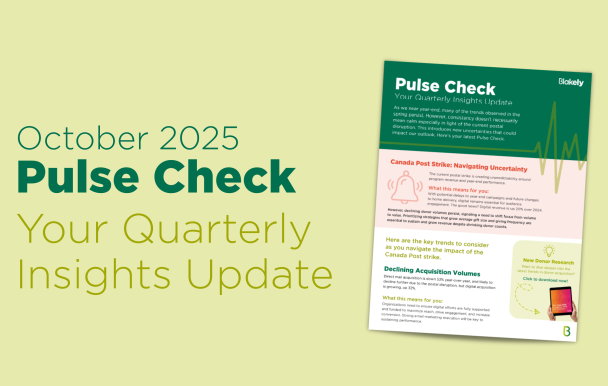
Integration Now: Why you need to mix a gin & tonic now more than ever before!
Let me start with some good news.
We ran surveys in the US and Canada to get a sense of donor attitudes right now, and the key learnings are as follows:
- Donors want you to keep fundraising and marketing
- People are more altruistic than ever before
- People are truly concerned about their neighbours, their communities, and their country
Don’t get me wrong – we are in an incredibly tough time, but these insights are encouraging. We need to keep communicating with donors, but we need to do things differently to reach them.
How do we do it? Their lives (like ours) are saturated with messages, information, and communications right now. At the same time, they’re still hungry for relevant content.
Integration Defined
If you haven’t already, it’s time to integrate your donor communications. What does that actually mean? Here’s how we like to define it: Different communications working together towards the same goal.
Integration isn’t complicated, but that doesn’t mean it’s easy, because it’s often not. For example, your own department structure might get in the way – marketing/communications and fundraising, perhaps. There are organizations where marketing and fundraising departments just don’t mix; they’re like oil & water.
We prefer to see marketing and fundraising as a gin & tonic. Together, your donor communications can be so much stronger when you’re sharing the work, and even sharing objectives, goals, results – and budgets! The combined power of these areas mean you can reach your audiences with a singular message that both inspires and drives action.
This is what’s really needed. There’s no room for messages that are unclear or disconnected from one another. In order to tell your story and amplify it, you need to integrate.
Where do you start?
“Integration” is a pretty over-used term and has a lot of connotations for different people, so let’s talk about what it is and what it isn’t:
| WHAT INTEGRATION IS NOT | WHAT INTEGRATION IS |
| The same creative repeated in every channel to every audience | Interpreting a single message across many channels for many audiences |
| Campaigns that end when the marketing manager is bored with the idea | Longevity: these campaigns continue to innovate, build and grow to amplify the message |
| Expected – the same idea said the same way over and over again | Surprising – even if you’ve seen the idea already, you see the campaign pop up or communicate with you in an unexpected way |
| Narrow – each individual piece starting and finishing the story at once | Broad – integrated campaigns lighten the load for individual pieces of the campaign and the donor has an active role in putting the pieces together and building the story |
| About one department | Shared – it needs full organizational buy-in – everyone has ownership and the opportunity to be innovative |
| Boring | Noticeable – easy to talk about them, share them, and wish you had done them |
| Expensive | Smart – stellar targeting, exceptional use of media, flawless execution |
Take the pressure off yourself now. Integration does not have to mean a highly produced, expensive, large-scale fundraising campaign. Since it’s about different communications working together towards the same goal, what it really involves is:
- Strategy – insights-driven, strong audience targeting, channel strategy, and seamless execution
- One singular message – interpreted for different channels and audiences
- Multiple channels (online/offline)
- Creativity – needs to grab attention and be shareable (doesn’t mean expensive, but it does mean compelling)
- A willingness to collaborate!
If that’s all it takes, anyone can integrate.
Why Now?
Something inspiring about the current context is how it’s driving people to try something new. On a personal level, I baked bread for the first time ever recently. I’m sure your Instagram/Facebook feed is like mine, so you’ve seen friends and family bake bread, try new dishes, host virtual parties, start new hobbies, take up gardening… the list goes on.
Organizations are doing this, too. One of our clients, Sunnybrook Hospital Foundation (health sciences centre in Toronto, Canada) has collaborated in a way they never had before. All departments uniting with a single, clarified purpose, and moving more nimbly, too. As Christina Topp, Vice President of Community Engagement, quoted: “Necessity is the mother of invention,” …or integration, as it were. What has resulted (because it’s still ongoing) is a communications journey that is seamless, singular, and amplified.
An approach like this also helps us move towards recovery planning. We may not know when recovery will be yet, but by innovating and collaborating and working in new ways, there’s the significant added benefit of making our organizations more efficient, sustainable, and effective. Regardless of where you stand from a financial perspective right now, integration will help you grow long-term.
9 Tips to Integrate Now
In conclusion, here are our top tips for integration:
- Plan – Revisit/Start your Q3/Q4 planning now. Be thoughtful about how to approach campaigns for the rest of the year (but also be nimble).
- Collaborate – Work with all necessary colleagues to make integration happen. It sometimes means a lot of players at the table, but with alignment, you can be so much more effective.
- Mix a G&T – Especially collaborate when it comes to Marketing & Fundraising. With shared objectives, you will connect better with your audiences.
- Start Small – There’s no point in overwhelming yourself; start with a key offline and online channel communicating a singular message and go from there. Positioning integration as a pilot/test/proof of concept could help get the internal support you need.
- Consider the Journey – Integration can’t be channel/touchpoint-specific; you need to look at the bigger picture of your communications journey as you work through it. Make sure you’re clear on where you are now, and where you’re headed. A great place to start right now would be onboarding new donors if your organization is responding to the COVID-19 pandemic in a direct way (or even if it’s not); what should their journey be?
- Know Your Proposition – A singular message needs a clear value proposition: Why should people give? Why should they give now? Why should they give to you?
- Know Your Audiences – Depending on where your organization sits in the context of the COVID-19 crisis, your priority audiences may differ. It may be time to focus on your most loyal donors (it is regardless), but you may also have new audiences to reach out to. Be clear on who you need to be reaching, and what they need from you, and keep checking in on this as we move from where we are now to recovery.
- Content is Queen – Continue to prioritize sourcing content right now. Find those stories that will really resonate with your audiences, and that you can share across multiple channels and assets.
- Be Clear on Your Goals – We still need to set clear goals and objectives for ourselves to stay on track, but we all need to be flexible, too. It’s the only way to go forward.









